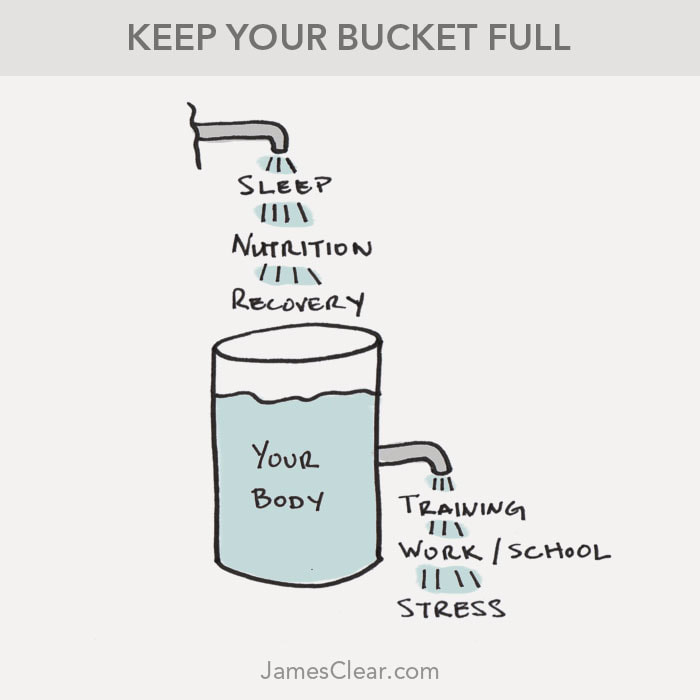Adaptations to Training
When we “use” our bodies, our bodies adapt to the activity we are doing. The more we do, the more we are able to do. The less we do, the less we are able to do. This is essential in eliciting a training response.
When we train we want to cause stress to our body. This may be our muscles, bones, cardiovascular system, etc. We want to overload the system, which causes a degree of damage or micro-trauma. The body then responds by growing bigger / stronger / faster / fitter, so it can cope with that load in future. We cause stress to force adaptations.
When we train we want to cause stress to our body. This may be our muscles, bones, cardiovascular system, etc. We want to overload the system, which causes a degree of damage or micro-trauma. The body then responds by growing bigger / stronger / faster / fitter, so it can cope with that load in future. We cause stress to force adaptations.
Stress/load => damage => rest/recovery => adaptation/growth.
Load
A lot of common gradual-onset injuries result from a failure to adapt to load.
There are a number of variables that can be multiplied to determine the total load:
The intensity of the activity is the most powerful multiplier in this list.
There are a number of variables that can be multiplied to determine the total load:
- Number of sessions per week
- Length of session
- Intensity of session
- Novel activity
- Bio-mechanical or environmental variables (eg, footwear, hills, ground surface)
The intensity of the activity is the most powerful multiplier in this list.
When we are considering total load, we also need to consider variables that make it harder for our bodies to adapt to load.
Variables that can be multiplied to determine how well we adapt to the load:
Recent research found that getting less than 8 hours sleep a day almost doubles the injury rate in athletes.
Variables that can be multiplied to determine how well we adapt to the load:
- Time between sessions
- Nutrition
- Hydration
- Stress
- Sleep
Recent research found that getting less than 8 hours sleep a day almost doubles the injury rate in athletes.
Injuries
The two most common over-loading, or over-use type injuries are:
Tendon pain is a failure of soft tissues to cope with muscular loading.
Stress fractures are a failure of the boney architecture to adapt to impact loading.
- Tendon pain
- Stress fractures
Tendon pain is a failure of soft tissues to cope with muscular loading.
Stress fractures are a failure of the boney architecture to adapt to impact loading.
Load Management
Our bodies like a consistent workload, i.e., doing the same things every day. If we need to do more, we have to make gradual changes to avoid overloading. Increases in total load need to be slow and steady. Increasing load by not more than 10% a week is commonly recommended.
We get in trouble when we have spikes of load.
We may rapidly increase training levels in preparation for an event. This is a common cause of injury during pre-season training.
Or it could be a resumption of “normal” training after a period of rest. Unfortunately, the body quickly adapts to the lower levels, so what was normal is now excessive. This is a common mechanism of a new injury, having spent some time rehabbing a previous injury.
An otherwise normal load may become excessive if we are not eating, drinking, or sleeping well, or are stressed. It’s very common to see regular runners breaking down in December when they’ve been going to Christmas parties.
We get in trouble when we have spikes of load.
We may rapidly increase training levels in preparation for an event. This is a common cause of injury during pre-season training.
Or it could be a resumption of “normal” training after a period of rest. Unfortunately, the body quickly adapts to the lower levels, so what was normal is now excessive. This is a common mechanism of a new injury, having spent some time rehabbing a previous injury.
An otherwise normal load may become excessive if we are not eating, drinking, or sleeping well, or are stressed. It’s very common to see regular runners breaking down in December when they’ve been going to Christmas parties.
Injury Management
Load management is an essential component of injury management.
Of the total volume of work, I get patients to dial down the load by about a quarter, and stop the most aggravating activities – most likely the more demanding / explosive activities: hopping, skipping, jumping, sprinting, hills, plyometrics. So usually total rest isn’t required.
Patients can keep going with their cardio, but possibly trial a lower impact, cross-training option.
Have you had an injury from excessive load? What was your experience?...
Of the total volume of work, I get patients to dial down the load by about a quarter, and stop the most aggravating activities – most likely the more demanding / explosive activities: hopping, skipping, jumping, sprinting, hills, plyometrics. So usually total rest isn’t required.
Patients can keep going with their cardio, but possibly trial a lower impact, cross-training option.
Have you had an injury from excessive load? What was your experience?...






